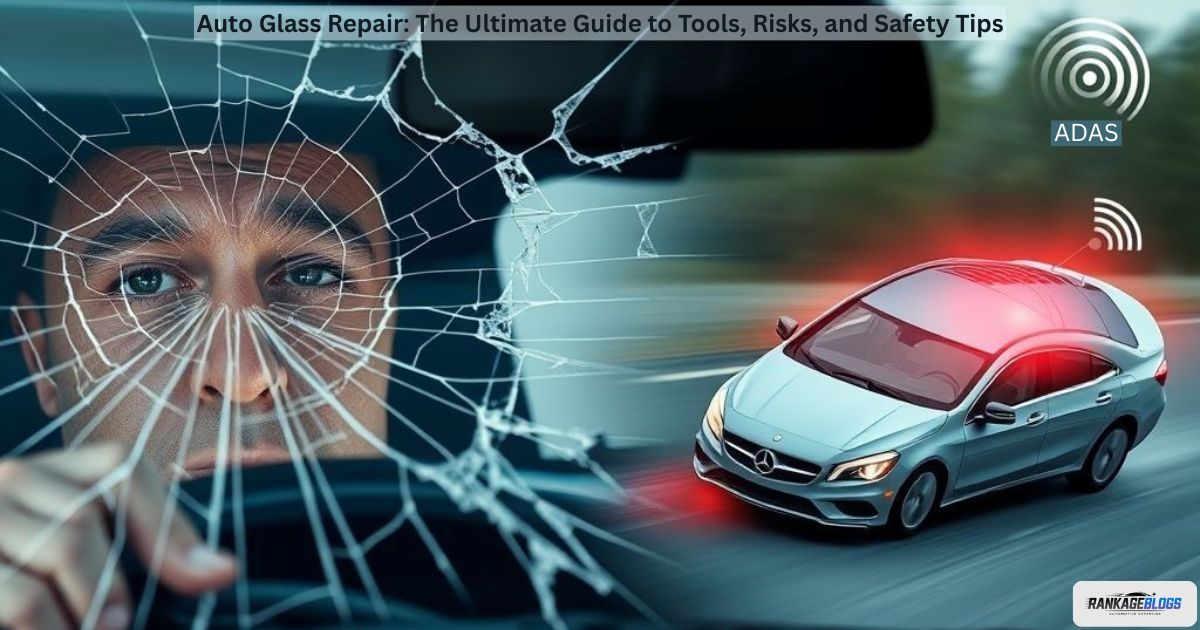Discovering a new chip or crack on your windshield can instantly ruin your day, leaving you worried about cost, complexity, and safety. This definitive guide to auto glass repair is your essential resource for cutting through the confusion. We will help you accurately understand the damage, evaluate the hidden dangers of ignoring it, and critically compare the tools and risks of a DIY repair against the benefits of professional help.
It’s crucial to remember that your windshield is a fundamental safety barrier; it provides up to 60% of your vehicle’s structural integrity in a rollover and is a calibrated platform for Advanced Driver-Assistance Systems (ADAS) like lane-keeping and automatic emergency braking. Making an informed decision is not just about aesthetics—it’s about ensuring your vehicle’s safety and your peace of mind on the road.
Immediate Assessment – Can Your Windshield Be Repaired?
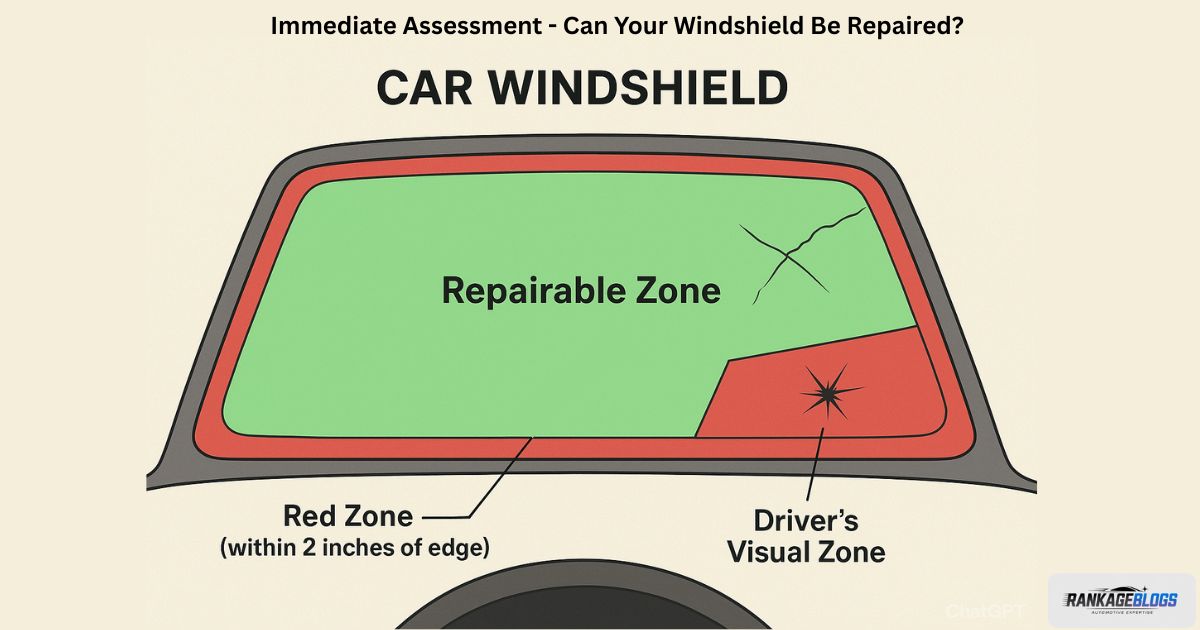
Before you decide on any course of action, you must first determine if your windshield damage is even repairable. Not all windshield chips and cracks can be fixed, and understanding the difference will save you time, money, and ensure your vehicle’s safety. This initial assessment is the most critical step in the entire process, guiding you toward the proper course of action.
The Quick-Answer Checklist
For a speedy evaluation, run through this scannable checklist. If you answer “yes” to any of these points, you almost certainly need a full replacement and should call a certified technician immediately:
- Is the damage larger than a dollar bill (typically 6 inches)?
- Is the crack within two inches of the windshield’s edge?
- Is the chip or crack directly in the driver’s line of sight?
- Are there multiple chipsor cracks in close proximity?
- Has dirt or moisture deeply contaminated the break?
Detailed Auto Glass Repair vs. Replacement Criteria
The criteria for Auto Glass Repair vs. Replacement are nuanced. Auto glass repair professionals follow strict guidelines, often based on ROLAGS standards (Repair of Laminated Auto Glass Standards).
- Size Guidelines: As a general rule, small chips less than 1 inch in diameter (about the size of a quarter) can often be repaired. Cracks shorter than 3 to 6 inches may also be repairable. Anything larger almost always requires a windshield replacement.
- Location is Critical: Damage directly in the driver’s line of sight is problematic. Even a successful repair can leave minor distortions that obscure visibility. Furthermore, damage on the windshield perimeter (within 2 inches of the edge) compromises the glass’s structural integrity and requires replacement.
- Depth & Contamination: A laminate windshield has two layers of glass with a vinyl interlayer. If the damage penetrates both layers, it is not repairable. If dirt, moisture, or other contaminants have filled the crack, it prevents the repair resin from bonding correctly, reducing the chance of a successful fix.
- Type of Damage: Common types include bull’s-eye chips (a circular break), star breaks (with legs radiating out), and combination breaks. A professional can determine the best auto glass repair technique based on the break pattern.
Visual Guide: The Windshield “Danger Zones”
The diagram below illustrates the critical “Danger Zones” where damage typically necessitates a full windshield replacement to maintain your vehicle and passenger safety.
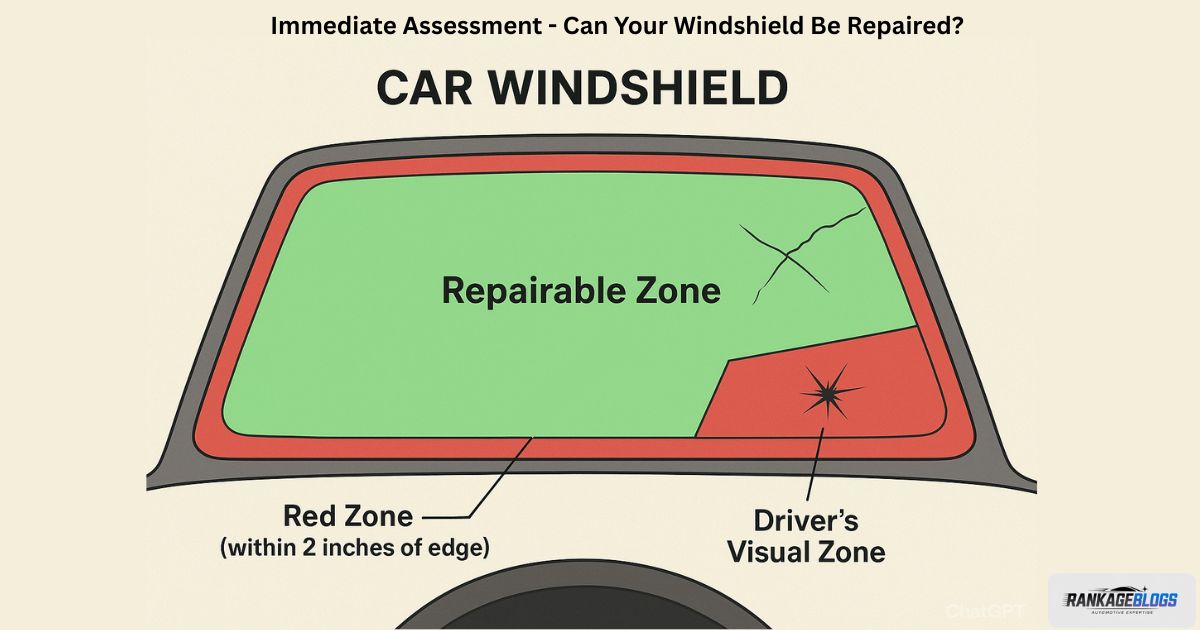
- Green Zone (Central Area): Small, isolated damage here may be repairable.
- Red Zone (Driver’s Line of Sight): Damage here often requires replacement to avoid optical distortion.
- Red Zone (Perimeter, within 2 inches of edge): Damage here compromises structural integrity and requires immediate replacement.
The Hidden Dangers of Damaged Auto Glass
Ignoring a chip or crack is about more than just a flawed view; it’s a significant safety gamble. A compromised windshield cannot perform its critical safety functions, putting you and your passengers at risk every time you drive. Understanding these hidden dangers is the key to prioritizing timely auto glass repair.
How Cracks Affect Structural Integrity in Collisions
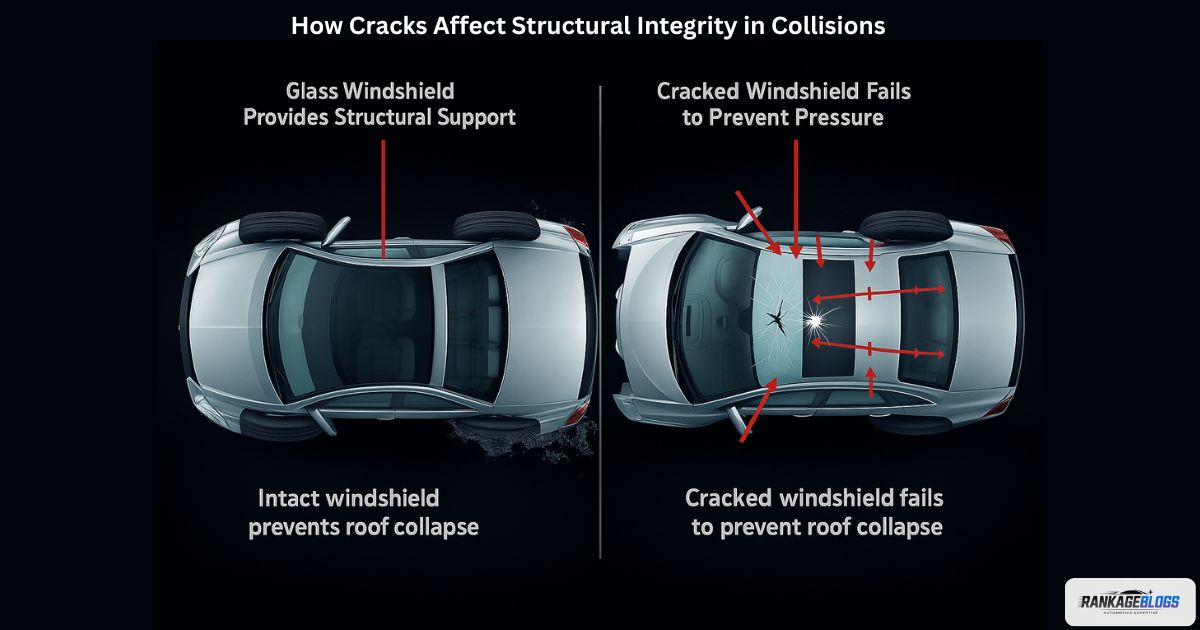
Your windshield is engineered to provide up to 60% of the passenger cabin’s structural integrity in a rollover accident. It prevents the roof from collapsing. A crack creates weak spots that can cause the entire windshield to fail under pressure, leading to catastrophic safety hazards. This structural vulnerability is the single most important reason to address damage immediately.
Impacts on Airbag Deployment Timing and Effectiveness
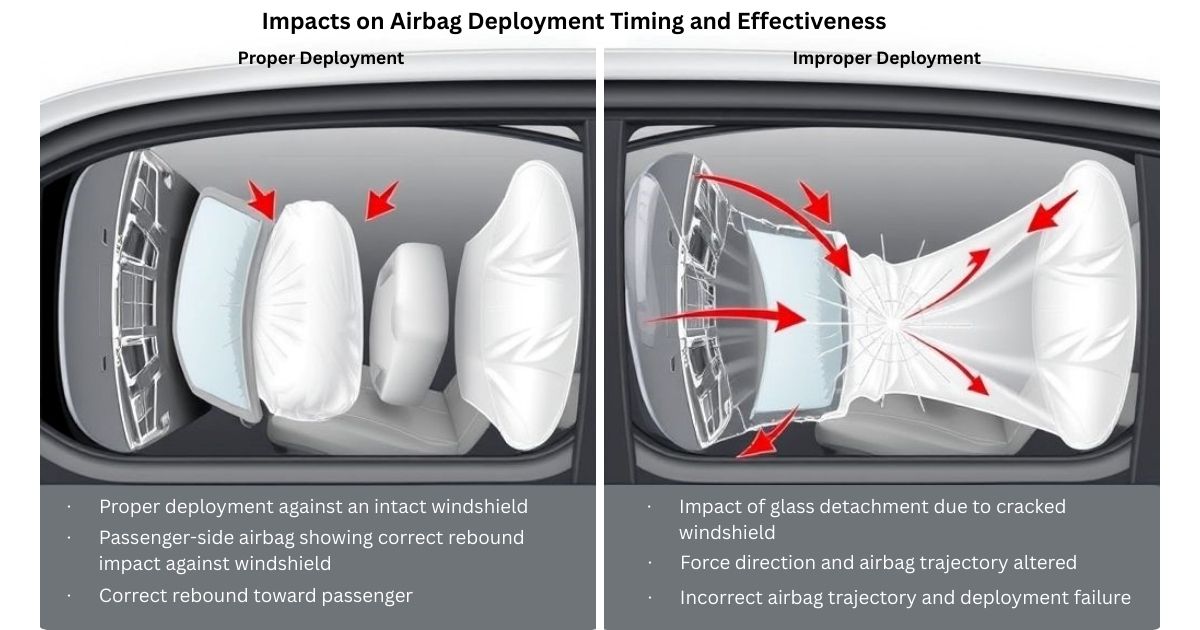
The windshield serves as a backstop for the passenger-side airbag. During deployment, the airbag inflates upward and rebounds off the glass toward the passenger. A compromised windshield may not withstand this force, causing it to detach or allowing the airbag to deploy improperly. This incorrect deployment can drastically reduce the airbag’s effectiveness in a collision.
Reduced Visibility and Increased Night Driving Hazards
Even a small chip can scatter light from oncoming headlights or the sun, creating a blinding glare and obscured vision. As cracks spread, they can create visual distortions and blind spots, making it difficult to see pedestrians, other vehicles, or road hazards, especially during low-light conditions or bad weather.
The Risk of Glass Shattering in Minor Accidents
Glass under stress is unpredictable. What might be a minor fender-bender for an intact vehicle could cause a weakened windshield to shatter entirely upon impact. This shattering eliminates a primary safety barrier, exposing occupants to flying debris and ejecting them from the vehicle.
How Vibration Makes Cracks Worse Over Time
The constant stress of normal driving—road vibrations, bumps, and flexing of the car’s frame—puts pressure on a crack’s delicate edges. Furthermore, temperature changes cause the glass to expand and contract, while moisture seeping into the crack freezes and thaws. These factors work together to turn a small chip into a major crack that spreads across your entire windshield.
The DIY Dilemma: Tools, Realistic Outcomes, and Hidden Risks
The allure of a DIY windshield repair kit is understandable: it’s affordable and seems straightforward. However, these kits represent a significant compromise and come with a host of unexpected risks that can turn a minor issue into a major, costly problem.
What’s Really in a DIY Kit?
A typical consumer kit contains a basic set of tools that pale in comparison to professional equipment. You usually get a vial of liquid resin, a simple applicator or bridge device, a pedestal, a razor blade, and a weak UV light or curing film for the curing process. The critical limitations are stark: they lack the powerful pressure injection systems to force resin deep into the crack, the professional-grade solvents for deep cleaning, and the high-intensity UV lamps for a complete, strong cure.
The Only Time to Consider a DIY Kit
A DIY project might be considered only as a temporary solution under very specific conditions: if the damage is a single, very small chip (less than 1 inch), located away from the driver’s line of sight and the edges, on an older vehicle without ADAS cameras. The sole goal is to prevent the crack from spreading until you can get a professional inspection. It is never a permanent fix.
The Stark Realities and Risks of DIY
Choosing the DIY path introduces numerous safety hazards and potential financial pitfalls.
- Cosmetic, Not Structural: The repair is often visible—opaque resin, bubbles in repair, or drip marks create an unsightly appearance and obscure visibility. It does not restore the original structural integrity.
- Botched Jobs Create Bigger Problems: Improper resin application can lead to cloudy windshield repair and distorted vision. Worse, a failed DIY attempt can seal contaminants inside, making a future professional windshield repair impossible and forcing a full replacement.
- Voids Insurance and Warranty: Many car insurance policies require repairs to meet certain safety standards. A poor repair can be grounds for an insurance denial on a future claim. It can also void warranty coverage on related parts.
- Health & Environmental Risks: The chemicals in these kits, including liquid resin, can emit toxic fumes and pose health risks like skin irritations and respiratory issues. They must be used in a well-ventilated area with safety glasses and gloves, and disposed of properly to minimize environmental impact.
- The True Cost: The biggest risk is turning a $0 insurance repair into a $500+ out-of-pocket expense for a windshield replacement.
The Professional Advantage: Process, Tools, and Guarantees
Opting for professional windshield repair is choosing safety, quality, and long-term value. Certified technicians use a precision-driven service with advanced tools and materials to deliver a result that is safe, reliable, and often backed by a strong warranty, providing true peace of mind.
Step-by-Step Professional Auto Glass Repair Process
A professional repair is a multi-step process designed for maximum effectiveness:
- Drilling: A tiny micro-hole is drilled at the end of the crack to stop its propagation immediately.
- Deep Cleaning: Specialized solvents are used to meticulously clean the cavity of all contaminants, ensuring a perfect bond.
- Pressure Injection: Using calibrated injection systems, high-quality resin is forced deep into every crevice of the damage under vacuum and pressure.
- Professional Curing: A high-power UV light or other professional method instantly cures the resin to its maximum hardness and clarity.
Superior Tools and Materials
The gap between DIY and pro is vast. Professionals use powerful pressure/vacuum pumps, intense UV curing lamps, and high-quality materials like optically perfect resins. For replacements, they use structural urethane adhesives that meet OEM specifications, unlike lower-quality hardware store alternatives. A critical choice is between OEM vs. Aftermarket Glass: OEM (Original Equipment Manufacturer) glass is made by your car’s maker, guaranteeing perfect fit, clarity, and compatibility with safety systems. OEE (Original Equipment Equivalent) glass meets the same strict standards and is a high-quality, often more affordable alternative.
The Importance of Certification and Standards
This is where safety is proven. Look for a certified technician with credentials from organizations like the Auto Glass Safety Council (AGS), which ensures technicians are trained to the highest industry standards like AGRSS (Auto Glass Replacement Safety Standards). Using OEM or OEE glass and certified installation procedures ensures your vehicle’s structural integrity and safety systems are restored correctly, keeping your vehicle warranty intact.
The Modern Safety Imperative: ADAS and Windshield Recalibration
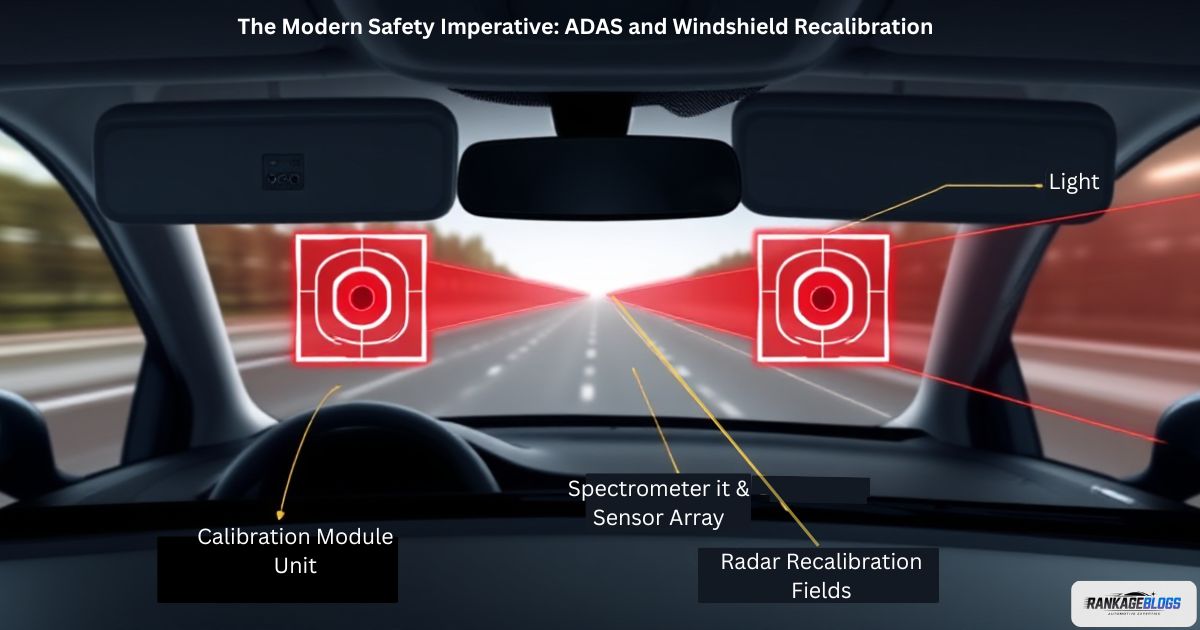
Modern vehicles have introduced a new layer of complexity to auto glass repair. The rise of ADAS has transformed the windshield from a simple window into a sophisticated optical component, making proper calibration a non-negotiable part of the windshield replacement process.
What is ADAS?
ADAS (Advanced Driver-Assistance Systems) are electronic systems that help the driver with driving and parking. They include features like automatic braking systems, lane departure warnings, adaptive cruise control, and more. These systems rely on cameras and sensors typically mounted behind the rearview mirror, which “look” through the windshield.
Why a Windshield Replacement is a Safety Procedure
Any windshield replacement changes the optical properties of the glass. Even a minute change in thickness, clarity, or angle can misalign these sensitive cameras. A miscalibrated camera can cause safety systems to fail—for example, an automatic braking system might not recognize a pedestrian or might brake unexpectedly. This is why a replacement is now a safety procedure, not just a cosmetic fix.
The Recalibration Process
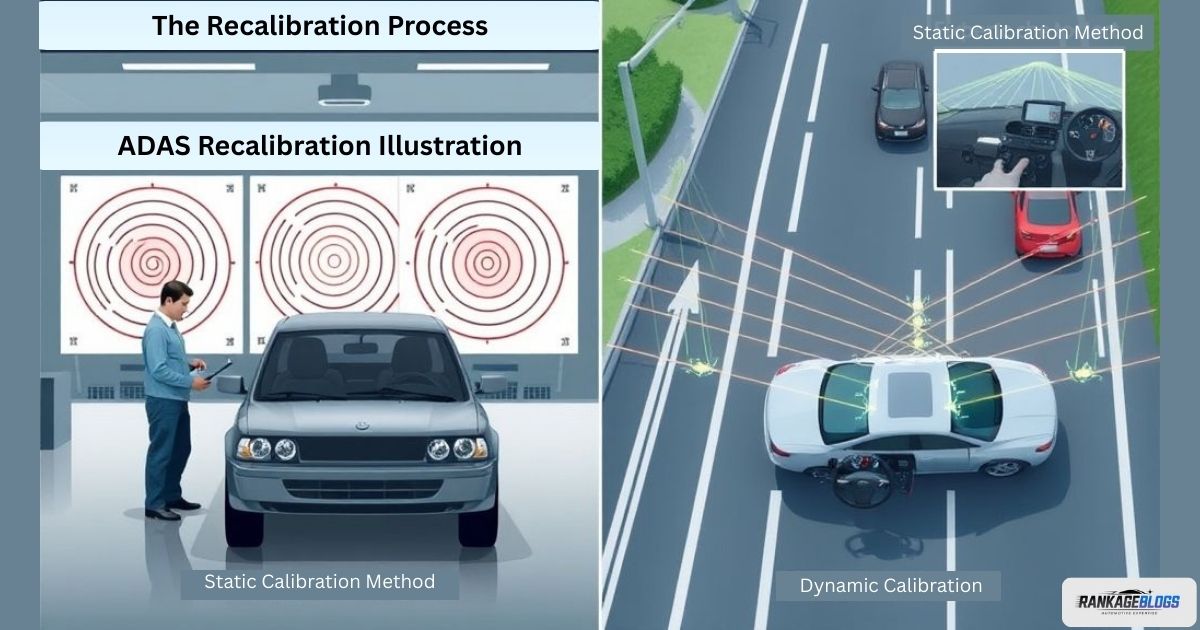
After most replacements or repairs near the camera mount, recalibration services are essential. There are two methods:
- Static Recalibration: The vehicle is placed in front of large, precise targets in a controlled shop environment. Technicians use software to align the cameras to the vehicle’s specifications.
- Dynamic Recalibration: The vehicle is driven on a clear road at a specific speed while the system calibrates itself using the environment (lane lines, other vehicles, etc.).
My Safety Features Stopped Working! If your ADAS features malfunction after a glass replacement, it almost certainly indicates a failed recalibration. Contact the service provider immediately to have it corrected.
Navigating Insurance, Cost, and Convenience
Understanding your financial options makes choosing the professional path easier. In most cases, professional windshield repair is far more cost-effective than DIY and is incredibly convenient.
Demystifying Insurance Coverage
Most comprehensive auto insurance policies cover auto glass repair and replacement. Many states have “no deductible” glass coverage laws, meaning you pay $0 for the service. It’s crucial to know that a glass claim is almost always considered “no-fault” and will not raise your insurance premiums. Always check your specific policy details.
The True Cost Analysis: DIY vs. Pro
For a deeper dive into the numbers, read our detailed Cost Analysis.
Let’s break down the real numbers:
- DIY: Kit cost ($10 – $50) + risk of a $500+ replacement + risk of void warranty + health risks + your time.
- Professional: Often $0 with insurance + a lifetime warranty + guaranteed safety standards + mobile services that save you time.
Ultimate Convenience: Mobile Service
Many auto glass repair shops offer mobile services, where a certified technician comes to your home, office, or even the grocery store parking lot to perform the repair or replacement on the spot. This is often more convenient than spending your own time on a risky DIY project.
How to Choose the Right Auto Glass Repair Service
Selecting a provider is about more than just price. Use this checklist to vet a trusted auto glass professional and ensure you receive a quality service that guarantees your safety.
Your Checklist for Vetting a Provider:
- ✅ Do they employ certified technicians (e.g., AGS certified)?
- ✅ Do they use quality materials (OEM/OEE glass, name-brand adhesives)?
- ✅ Do they offer and perform ADAS recalibration services?
- ✅ Do they provide a strong, transferable lifetime warranty?
- ✅ Do they handle the insurance claim paperwork for you?
- ✅ Do they offer convenient mobile services?
- ✅Can they provide a detailed, transparent quote with flat-rate pricing and no hidden fees?
Post-Repair: Aftercare, Warranty, and Troubleshooting
Your responsibility doesn’t end once the technician leaves. Proper aftercare ensures the longevity of the repair or replacement and helps you understand what to expect.
Immediate Aftercare Instructions
More essential aftercare tips here.
- Driving: For a repair, you can usually drive immediately. For a replacement, you must typically wait at least one hour before driving and avoid car washes for 24-48 hours to allow the adhesive to cure fully.
- Washing: Avoid high-pressure water streams on the glass edges for at least 24 hours after a replacement.
Understanding Your Warranty
A reputable provider will offer a strong warranty. A good warranty covers both parts and labor against defects, leaks, wind noise, and discoloration for the life of your vehicle ownership. Always get the warranty details in writing.
Troubleshooting Common Post-Installation Issues
- Leaks: A sign of improper sealing. Contact the installer immediately for repair.
- Wind Noise: Often indicates an installation issue with the molding or sealant.
- Visual Distortion: Unacceptable in a new windshield or repair. This is a valid reason to demand a redo from the service provider.
Conclusion: Making the Safe and Smart Choice
The choice is clear. A DIY windshield repair is a high-risk gamble that offers, at best, a temporary fix for minor damage. Ignoring damage or repairing it improperly jeopardizes your safety, your passengers’ safety, and your wallet.
The professional path is the smarter choice: it is often free through insurance, incredibly convenient with mobile services, backed by a lifetime guarantee, and, most importantly, it restores the structural integrity and safety of your vehicle. For your peace of mind and safety, always trust a certified auto glass repair technician.
Comprehensive FAQ: Answering Your Specific Scenarios
- Is it safe to drive with a rock chip or crack?
Yes, but only if the chip is very small. Stress, temperature changes, or road vibrations can quickly cause it to spread into a dangerous crack. - What’s the difference between a DIY repair kit and professional service?
DIY kits offer a temporary, often cosmetic fix with consumer-grade resin, while professional repair uses advanced tools and UV-cured resin for a stronger, clearer, and permanent result. - How does a professional repair a windshield?
They use a specialized drill, injection pump, and UV light to cure high-grade resin, fully saturating the crack to restore strength and clarity. - Can all types of glass damage be repaired?
No, complex cracks, damage on edges, or damage on tempered glass (like sunroofs) usually require a full replacement. - Can a crack on a rear window with defroster lines be repaired?
It is possible but requires extreme skill to avoid damaging the lines; often, replacement is the safer, more reliable option. - How long does a professional repair last?
A proper professional repair is designed to be a permanent fix that lasts for the life of the vehicle. - What is the AGRSS standard?
The Auto Glass Replacement Safety Standard (AGRSS) is the key guideline promoting proper procedures for safe auto glass installation and occupant safety. - Is mobile repair service as effective as shop service?
Yes, a reputable mobile service brings the same specialized tools, materials, and expertise to your location, offering identical quality. - My window has a small pit but no crack – what should I do?
Have it evaluated by a pro; they can often fill the pit to restore surface smoothness and prevent a crack from forming. - Can a previously repaired spot be fixed again?
Generally, no. Once resin has been injected, it seals the break, making a second attempt rarely successful. - Is auto glass repair a good business to start?
Yes, it’s a stable industry with high demand, recurring revenue from insurance work, and relatively low overhead.

